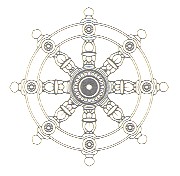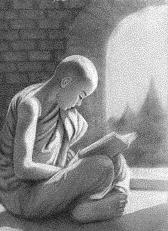|
Dharma Wheel |
|
 A
Buddhist emblem resembling a wagon wheel, with eight spokes, each
representing one of the eight tenets of buddhist belief. The circle
symbolizes the completeness of the Dharma, the spokes represent
the eightfold path leading to enlightenment. A
Buddhist emblem resembling a wagon wheel, with eight spokes, each
representing one of the eight tenets of buddhist belief. The circle
symbolizes the completeness of the Dharma, the spokes represent
the eightfold path leading to enlightenment.
It is drawn from an Indian
symbol, but instead of representing Samsara, or endless rebirth, it
symbolizes overcoming obstacles.
|
|
According to tradition the Wheel of Dharma
was set in motion three times:
-
in Sărnăth where
Buddha pronounced his first discourse after attaining complete
enlightenment
-
through origination of the Mahăyăna
-
through the arising of the Vajrayăna
|
|
The Four Noble Truths |
|
The Four Noble Truths – the teaching
about misery, the cause of misery, that this cause can be
eliminated, and that misery can be ended by following the correct
path:
-
Everything that exists is filled
with suffering
-
Suffering is
caused by desires
-
You can get rid
of suffering by stifling all desire
-
The
Noble Eightfold Path leads to the
end of suffering
|
|
The Noble Eightfold Path of Buddhism |
-
Right View
-
Right Thought
-
Right Speech
-
Right Behavior
-
Right Livelihood
-
Right Effort
-
Right Mindfulness
-
Right
Meditation
|
 |
|
|
|
Buddha's Teachings |
|
Character, Personality
Though he should conquer a thousand men in the battlefield a thousand
times, yet he, indeed, who would conquer himself is the noblest victor.
All that we are is the result of what we
have thought.
The thought manifests as the word; The word
manifests as the deed; The deed develops into
habit; And habit hardens into
character. So watch the thought and its ways with care, And let it
spring from love born out of concern for all beings.
He is able who thinks he is able.
Relationships
Do not speak harshly to any one; those who
are spoken to will answer thee in the same way. Angry speech is painful:
blows for blows will touch thee.
Hatreds never cease by hatreds in this
world. By love alone they cease. This is an ancient Law...
More
|
|
Buddhadharma
Buddhism, or Buddhadharma, is Buddha’s
teachings and the inner experiences or realizations of these teachings.
Buddha gave eighty-four thousand teachings. All these teachings and the
inner realizations of them constitute Buddhadharma.
Buddhadharma does not stay in one place but
moves from one country to another. Just as gold is precious and rare, so
Buddhadharma is precious and very hard to find. Buddha taught how to examine
our mind and see which states produce misery and confusion and which states
produce health and
happiness.
He taught how to overcome the compulsively non-virtuous minds that confine
us to states of discontent and misery, and how to cultivate the virtuous
minds that liberate us from pain and lead us to the bliss of full
enlightenment. By learning Buddhadharma, we will have the opportunity to
gain the happiness we seek and to fulfill all our temporary and ultimate
wishes.
→
The Wheel of Life in
Buddhism
Buddha about Happiness
Tame the mind. This is the greatest challenge before you. It rushes
here and there, swifter than the wind, more slippery than water. If you can
arrest the flights of the mind to your will,
happiness will be assured to
you.
What is
Dharma?
"Dharma" means "protection". By practicing
Buddha's teachings we protect ourselves from suffering and problems. All the
problems we experience during daily life originate in ignorance, and the
method for eliminating ignorance is to practice Dharma.
Practicing Dharma is the supreme method for
improving the quality of our human life. The quality of life depends not
upon external development or material progress, but upon the inner
development of peace and happiness. For example, in the past many Buddhists
lived in poor and underdeveloped countries, but they were able to find pure,
lasting happiness by practicing what Buddha had taught.
If we integrate Buddha's
teachings into our daily life, we will be able to solve all our inner
problems and attain a truly peaceful mind. Without inner peace, outer peace
is impossible. If we first establish peace within our minds by training in
spiritual paths, outer peace will come naturally; but if we do not, world
peace will never be achieved, no matter how many people campaign for it.
The Wheel of Dharma
The
Wheel of Dharma, or the Wheel of the Teaching, is the translation of the
Sanskrit word, "Dharma cakra" (dharma-chakra). Similar to the wheel of a
cart that keeps revolving, it symbolizes the Buddha's teaching as it
continues to be spread widely and endlessly. The eight spokes of the wheel
represent
the Noble Eightfold Path of Buddhism, the most
important Way of Practice. The
Noble Eightfold Path refers to right view, right thought, right speech,
right behavior, right livelihood, right effort, right mindfulness, and right
meditation. In the olden days before statues and other images of the Buddha
we made, this Wheel of Dharma served as a the object of worship. At the
present time, the Wheel is used internationally as the common symbol of
Buddhism.
After he had attained
enlightenment, as a result of requests Buddha rose from meditation and
taught the so-called first "Wheel of Dharma. These teachings, which include
the Sutra of the Four Noble Truths and other discourses, are the principal
source of the Hinayana, or Lesser Vehicle, of Buddhism. Later, Buddha taught
the second and third Wheels of Dharma, which include the Perfection of
Wisdom Sutras and the Sutra Discriminating the Intention, respectively.
These teachings are the source of the Mahayana, or Great Vehicle, of
Buddhism.
In the Hinayana teachings, Buddha explains how to attain
liberation from suffering for oneself alone. In the Mahayana teachings he
explains how to attain full enlightenment, or Buddhahood, for the sake of
others. Both traditions flourished in Asia, at first in India and then
gradually in other surrounding countries, including Tibet. Now they are also
beginning to flourish in the West.
Buddha's teachings, which
are known as "Dharma", are likened to a wheel that moves from country to
country in accordance with changing conditions and people's karmic
inclinations. The external forms of presenting Buddhism may change as it
meets with different cultures and societies, but its essential authenticity
is ensured through the continuation of an unbroken lineage of realized
practitioners. Buddha's teachings are
said to be like a precious wheel because, wherever they spread, the people
in that area have the opportunity to control their minds by putting them
into practice.
The
Dhammapada
The Dhammapada is a versified Buddhist
scripture traditionally ascribed to the Buddha himself. It is one of the
best-known texts from the Theravada canon.
The title, Dhammapada, is a compound term
composed of dhamma and pada, each word having a number of denotations and
connotations. Generally, dhamma can refer to the Buddha's "doctrine" or an
"eternal truth" or "righteousness" or all "phenomena"; and, at its root,
pada means "foot" and thus by extension, especially in this context, means
either "path" or "verse".
Buddha's Path To
Liberation
From right understanding proceeds right
thought;
from right thought proceeds right
speech;
from right speech proceeds right
action...
More
Buddha about Conquering
Conquer the angry man by
love
Buddha Healing Mantra
May the many sentient beings who are sick,
quickly be freed from sickness.
And may all the sicknesses of beings never arise again.
The Value of Leading a Balanced Life
Balance is a key element of a
happy life.
Dalai Lama
teaches, 'A balanced and skillful approach to life, taking care to avoid
extremes, becomes a very important factor in conducting one's everyday
existence... More
Happiness – It's All in Our Own Hands
Here are three little anecdotes that I'd
like to share with you. They concern three sisters: Arom, Aporn, and
Arpa. Taken together, the trio of anecdotes tells us how to
cope with problems, how to turn the negative into the positive. If
we can do that, then we'll have a definite guarantee that, regardless of
what we encounter, we won't suffer as much or as easily as we did
before. That is our true guarantee of
happiness.
Thailand: 11 Tips for Visitors
Thailand is a Buddhist country where Buddha images are held secret.
Sacrilegious acts are punishable by imprisonment even if committed
by foreign visitors.
|